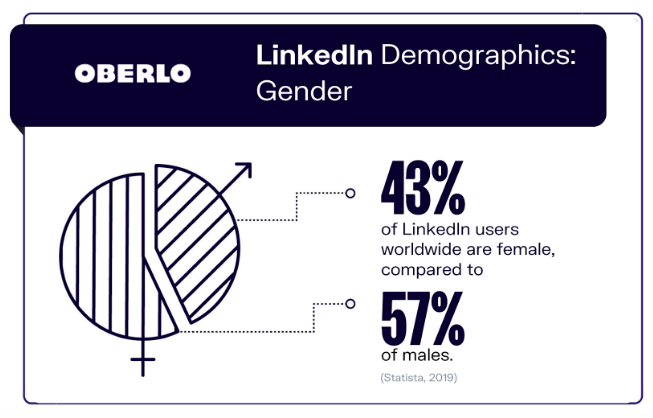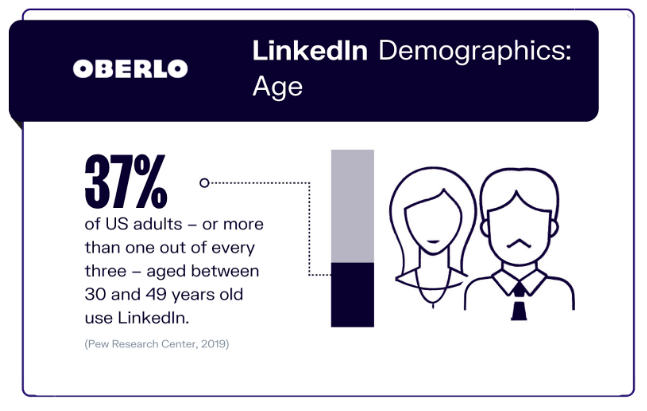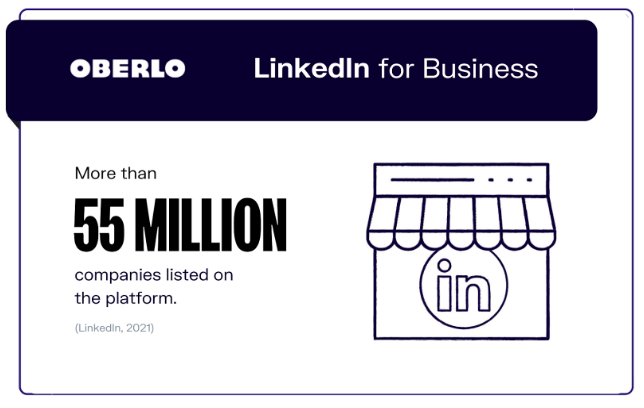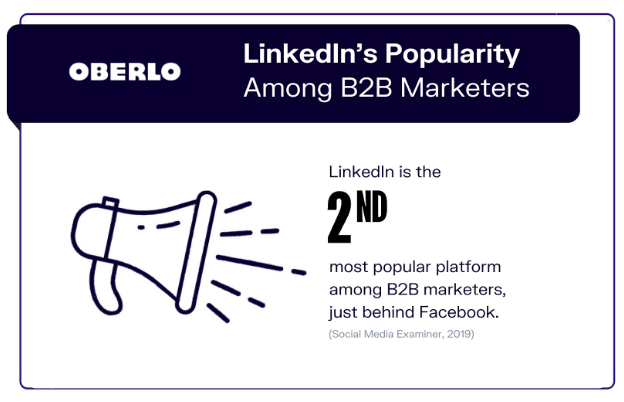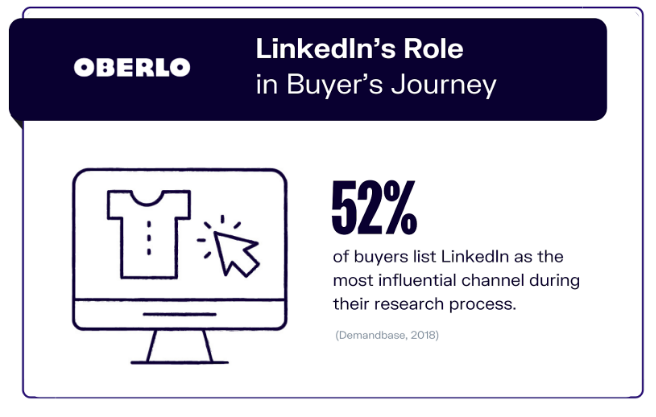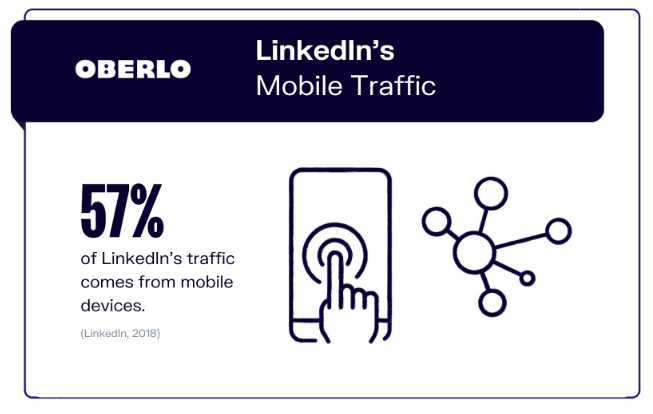Events –
https://www.webdesignmuseum.org/web-design-history/timeline-1995-1997
https://www.booksaresocial.com/timeline-social-media-2017/
https://vamp-brands.com/blog/2020/02/28/evolution-of-social-media/
https://online.maryville.edu/blog/evolution-social-media/
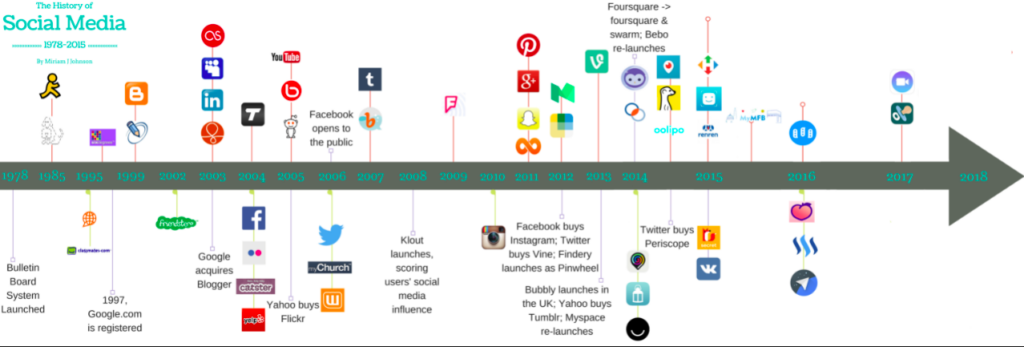
1969 – PARC invents the first desktop computer
1970 – 1990 – Internet access primarily at research centers and universities
1971 – first email sent
1980 – Ted Nelson emphasis on P2P – Xanadu
1991 – Sir Tim Berners-Lee creates WWW.Browser
1992 – WWW goes into the home
1992 – AOL goes online
1994 – Apple’s eWorld launches
1993 – Jim Clarke sells SGI and invests in Marc Andressen’s MOSAIC
1994 – MOSAIC becomes Netscape
1994 – First Web Banner Ad
1995 – Batman Forever website goes up
1995 – Netscape goes IPO
1995 – Amazon.com launches
1995 – Websites – 26,000 —- 2021 – 2 Billion websites – 80,000% increase
1998 – Google is registered – Larry Page and Serge Brin – Graduate students
1999 – Paypal launches anew – Peter Thiel and Max Levchin
2000 – Y2K – yikes
2002 – PayPal is sold to eBay for $1.5 billion
2002 – Friendster launches
2004 – 2007 – Paypal Mafia
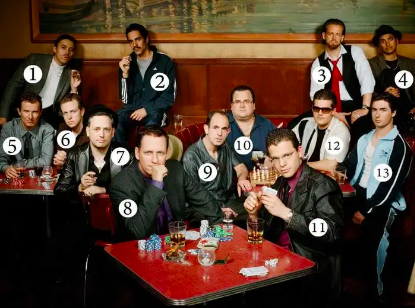
Back row from left: Jawed Karim, co-founder Youtube; Jeremy Stoppelman CEO Yelp; Andrew McCormack, managing partner Laiola Restaurant; Premal Shah, Pres of Kiva; 2nd row from left: Luke Nosek, managing partner The Founders Fund; Kenny Howery, managing partner The Founders Fund; David Sacks, CEO Geni and Room 9 Entertainment; Peter Thiel, CEO Clarium Capital and Founders Fund; Keith Rabois, VP BIz Dev at Slide and original Youtube Investor; Reid Hoffman, Founder Linkedin; Max Levchin, CEO Slide; Roelof Botha, partner Sequoia Capital; Russel Simmons, CTO and co-founder of Yelp.
2004 – Facebook launches
2005 – YouTube, Blogger, and Reddit launch
Soaring NFT sales redraw the art market I FT Film
NFT Explained Yet Again
https://www.esquire.com/entertainment/a35742083/what-are-nfts-explained/
2003 – LinkedIn

Mission
The mission of LinkedIn is simple: connect the world’s professionals to make them more productive and successful.
Who is Reid Hoffman?
LinkedIn began in co-founder Reid Hoffman’s living room in 2002 and was officially launched on May 5, 2003. Today, LinkedIn leads a diversified business with revenues from membership subscriptions, advertising sales and recruitment solutions under the leadership of Ryan Roslansky. In December 2016, Microsoft completed its acquisition of LinkedIn, bringing together the world’s leading professional cloud and the world’s leading professional network.
Hoffman’s Beginnings
Born in 1957 in Palo Alto, California, Hoffman was destined to be a Silicon Valley legend. Hoffman’s first paid job was as an editor at a video game company called Chaosium. After that, his newfound love for the business world prompted him to ask his parents to send him to The Putney School, a boarding school in Vermont. He later attended Stanford University for his bachelors and then the University of Oxford, where he earned his masters in philosophy. Hoffman read philosophy at Oxford because he wanted to strengthen public intellectual culture to make a significant impact on the world.
From Oxford to Silicon Valley
After realizing that academia wasn’t for him, Hoffman moved to Silicon Valley to create startups of his own. He pitched his ideas to investors, but since he was new to the game, they wouldn’t give him the time of day. They told him to get a job first. Hoffman networked his way into gigs at Apple and Fujitsu. After a while, he began to raise funding and started one of the first social media networks called SocialNet in 1997. The startup soon failed and Hoffman was ready to start something else, but fate had other plans.
In 1998, Hoffman’s old buddy Peter Thiel, another Stanford grad, called to convince him to join him at PayPal, instead of starting a new business. Hoffman decided to join PayPal as a board member and, two years later, came on full time as the Executive Vice President. By 2002, the startup caught the attention of eBay and sold for $1.5 billion.
Microsoft Bought LinkedIn for $26.2 Billion
Later in 2002, Hoffman took what he learned from starting his own social network in 1997 and started LinkedIn. He bankrolled the venture with his cash from the eBay acquisition. LinkedIn would maintain crazy momentum and gain the attention of tech-giant Microsoft. In 2016, Microsoft bought the company for a whopping $26.2 billion!
Hoffman is Still Winning at His Biz Goals
After Hoffman’s newfound billionaire status, he has gone back to the basics of investing and applying his intellect across multiple platforms. Rekindling his love of philosophy, he produces his own podcast, Masters of Scale, and writes books and essays. Currently, he is funding startups as an investor at the Venture Capital Firm known as Greylock Partners. With an investment portfolio that includes Facebook, Digg, Zynga, Flickr, Last.fm and more, there is no doubt that this founder will continue to learn from his experiences to continue building amazing products and services. Check out this in-depth interview with Reid Hoffman and what he thinks is the single most important quality when looking at founders, here.
The Takeaway
Reid Hoffman is one of many Silicon Valley legends that serves as a great role model for young entrepreneurs. His story proves that if you truly have a passion for something and put in work to further that passion, you will succeed. Hoffman is also a fantastic example of someone who has learned from his past experiences and who grows as an entrepreneur with every new business move he makes.
https://resources.banknovo.com/get-inspired-by-linkedin-founder-reid-hoffmans-business-journey/
Summary:
LinkedIn is an online professional networking site that allows individuals to post resumes and connect with others. Founded in 2003 by several veteran Silicon Valley entrepreneurs, the original insight that led to the company’s founding was the lack of an online community for vocational relationships and career advancement. Structured as a Freemium model, the core functionality of posting job experiences and linking with other people in the workforce is free to anyone willing to sign up. More advanced functionality costs money and focus on recruiting, getting hired, or other fundamental needs. Today the platform has over 600 million users in in over 200 countries. In 2016, LinkedIn was purchased by Microsoft for $26 Billion making it one of the largest tech acquisitions to date.
Business Model:
LinkedIn operates as a very cleverly designed two sided marketplace. Using its free professional networking service to attract users, it then connects companies to potential employees, and employees to new employers. On both sides of the platform, they make money.
LinkedIn statistics
Company Side
About two thirds of LinkedIn’s revenue comes from Talent Solutions, which it sells as an enterprise software to companies for recruiting. They offer several tools that enable in house recruiters to quickly identify possible candidates, and send targeted job postings to individuals who match selection requirements. They also offer paid marketing solutions for companies to build an organizational brand on the site and send targeted advertising.

Figure 1: Talent Solutions Offering
User Side
Users are able to create connections with other individuals and track the careers of peers for free. If an individual or member of an organization has a specific need, they can pay for a subscription service that unlocks extra features.
Figure 2: Premium Subscription Types
Through its business model, LinkedIn enables more liquidity within the job market and through targeted recruitment / hiring tools, allows for faster company growth. The value this service creates through the capture of user and company data is undeniable.
Data Assets:
The data that LinkedIn captures from its users allows it to create targeted job advertising and automatic filtering for recruitment candidates. The more users on the site, the more employers are attracted to use it, creating exemplary direct network effects. Advanced algorithms and analytics run on the vast amount of information that LinkedIn has on employee backgrounds and company hiring practices, has given it a substantial asset that it continues to leverage. Similar to other companies, LinkedIn uses this data lake to make smart recommendations, pair entities on both sides of the marketplace, create targeted advertising, and more recently offer customized learning resources.
The management of this dataset is critical to LinkedIn’s business model. Using the traditional freemium strategy, they have amassed a huge user base that has become a valuable asset for their customers. The company had to invest vast amounts of capital into marketing to become the designated online professional network for people to chose and into infrastructure to manage the high demands of such a platform. Without these data however, LinkedIn would have no ability to provide additional insights or suggestions to companies looking to hire its users. It’s precisely because of the data it has centralized, that it can monetize its products for talent acquisition that makes up such a disproportionate amount of the company’s revenue.
Conclusion:
In conclusion, LinkedIn is a great example of a data driven business. Using a traditional two sided marketplace approach, it has gathered a massive dataset on the professional background of the global workforce and the hiring practices of the companies that they work for. These data have generated substantial value and become an asset the the company maintains, protects and leverages through its business model.
[1] Pahwa, Aashish. 2019. “How Linkedin Makes Money? Linkedin Business Model | Feedough”. Feedough. https://www.feedough.com/how-linkedin-makes-money/.
[2] “Linkedin Direct Ads Vs Google Adwords”. 2019. Shoutex Digital Marketing. https://shoutex.com/blog/linkedin-directads-google-adwords-ppc-1/.
[3] “Linkedin: Log In Or Sign Up”. 2019. Linkedin: Log In Or Sign Up. https://www.linkedin.com/.
[4] “Understanding Linkedin Business Model”. 2019. Understanding Business Models. https://businessmodelinnovationmatters.wordpress.com/2012/05/16/understanding-linkedin-business-model/.
10 LINKEDIN STATISTICS EVERY MARKETER SHOULD KNOW IN 2021
by Ying Lin
14 Mar, 2021
Embarking on an ecommerce venture and not quite sure how to begin marketing? Considering the ever-increasing use of social media, this is a great first step when it comes to your internet marketing strategy.
From Facebook and Twitter to YouTube and Snapchat, your target audience can be found across many different social media platforms. But before launching yourself into social media marketing, you should consider the demographics and users of each of these platforms and their potential.
LinkedIn is one of the most popular social media sites in the world today and it calls itself “the world’s largest professional network.” Given its more formal and professional image, a LinkedIn strategy can differ greatly from that of other social media sites.
To understand how to optimize your LinkedIn marketing strategy, you’ll first need to understand the different LinkedIn demographics, including the number of LinkedIn users, its gender divide, LinkedIn’s advertising statistics, etc.
In this article, we’ll list 10 important LinkedIn statistics you should consider when launching your ecommerce brand’s social media marketing strategy. Let’s jump right in!
1. Number of LinkedIn Users
LinkedIn boasts over 740 million users in more than 200 countries and territories across the globe (LinkedIn, 2021).
Officially launched in 2003, LinkedIn’s growth has been nothing short of phenomenal. In just two years, it amassed 1.6 million members.
Even so, this initial LinkedIn growth rate was relatively slow compared to the spurt it achieved after going public in 2011. In the five years that followed, LinkedIn nearly tripled its user base from 160 million to 400 million. Just a year later in 2017, it crossed the half-a-billion mark.
Today, nearly half (48.4 percent) of its users come from North America and Europe. Specifically, 194 million are in North America and 166 million in Europe.
However, the region with the highest number of LinkedIn users is Asia Pacific, home to more than 201 million users. There are 110 million LinkedIn users in Latin America and 65 million in the Middle East and Africa.
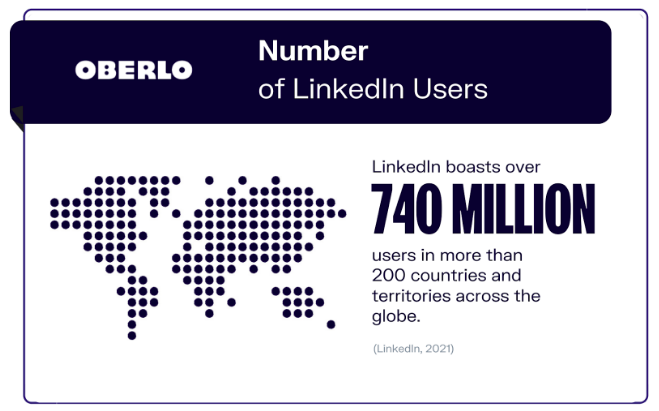
2. LinkedIn Demographics: Gender
Looking at LinkedIn’s demographics, and more specifically at the gender divide, the professional network is more popular among males than females.
57 percent of LinkedIn users worldwide are male, compared to 43 percent of females (Statista, 2019). LinkedIn statistics also suggest very different engagement habits with the platform between men and women.
Women are slightly more selective about their job applications and feel that they have to satisfy 100 percent of the stated requirements before applying (compared to just 60 percent by males). Interestingly, women also apply to 20 percent fewer jobs than men.
The tables turn, however, after the application process: women are 16 percent more likely than men to get hired after applying.
3. LinkedIn Demographics: Age
When setting up a LinkedIn ad campaign, you should also consider the LinkedIn age demographic.
37 percent of US adults – or more than one out of every three – aged between 30 and 49 years old use LinkedIn (Pew Research Center, 2019). This is the largest age group US LinkedIn users fall into, after which is the 18 to 29 years old age group making up 28 percent.
In terms of global usage, the majority of LinkedIn users – or 38 percent, to be exact – are between 25 and 34 years old. 35- to 54-year-olds account for 30 percent of the platform’s total user base, followed by 24 percent of users in the 18- to 24-year-old category.
It is also this latter group in which LinkedIn’s popularity is growing the fastest. As it stands, 18- to 24-year-olds make up a quarter of LinkedIn’s overall advertising audience.
4. LinkedIn Demographics: Education
When planning a LinkedIn ad campaign, it’s also important to consider other LinkedIn demographics such as the academic backgrounds of your target audience.
You may be interested to know that half of all US adults with college degrees use LinkedIn (Pew Research Center, 2018). In comparison, just 42 percent, 39 percent, and 32 percent of all college graduates in the US use Instagram, Pinterest, and Twitter respectively.
The usage of LinkedIn among US college graduates is, however, much lower than that of YouTube and Facebook. 85 percent and 77 percent of US adults who have graduated from college use YouTube and Facebook respectively.
5. LinkedIn Demographics: Job Seniority
With hundreds of millions of LinkedIn users, there are plenty of interest and targeting options for marketers who want to advertise on LinkedIn. To do that, aside from understanding your target audience, you also need to understand the type of audience that’s on LinkedIn.
LinkedIn is the biggest business social media site. This means that the audience you’re targeting is made up of professionals who engage on the platform on a business level. Not just that, statistics show that four out of five LinkedIn members have the influence to drive business decisions.
Since LinkedIn allows you to research and target your audience by seniority, it is important for marketers to understand the demographics of those professionals on the site.
According to LinkedIn, of all its users, 180 million are senior-level influencers (LinkedIn, 2021). That makes up nearly 25 percent of its total user base.
At 63 million, more than one in eight LinkedIn users are decision-makers and about 10 million are categorized as C-level executives.
6. LinkedIn for Business
As a professional network, LinkedIn is popular not only among job seekers but also businesses, with more than 55 million companies listed on the platform (LinkedIn, 2021).
However, this doesn’t mean that all of these 55+ million business listings are created and managed by their respective companies as LinkedIn automatically generates business listings when a user adds experiences from organizations that are yet to be listed.
Even then, this still means that LinkedIn is well on its way to its goal of getting all 70 million companies in the world to have a profile on its network.
As it stands, these registered companies are listing millions of jobs on the platform – and to much success: LinkedIn statistics show that three people are hired through their platform every single minute.
These LinkedIn statistics only go to show the dominance of the platform in the professional work environment. In fact, every single Fortune 500 company is represented on the platform by at least one upper-level representative.
7. LinkedIn’s Popularity Among B2B Marketers
Of all the social media sites, LinkedIn is the second-most popular platform among B2B marketers, just behind Facebook (Social Media Examiner, 2019).
Four out of every five B2B marketers use LinkedIn, compared to 91 percent of B2B marketers who use Facebook. That puts it ahead of Twitter, Instagram, and YouTube, which are used by 67 percent, 66 percent, and 54 percent of B2B marketers respectively.
Despite its popularity among B2B marketers, the professional network doesn’t seem to be quite as popular as a marketing platform for businesses as its rival, Facebook. Just 14 percent of marketers chose LinkedIn as the most important platform for their business, while 61 percent chose Facebook.
Marketing activities on LinkedIn may, however, be on the rise. 70 percent of B2B marketers are planning on increasing their organic activities on the platform – something to consider for your LinkedIn strategy.
8. Reach of LinkedIn Ads
The previous LinkedIn statistic should come as no surprise, considering that LinkedIn is an advertising goldmine that’s constantly growing. This is especially important for brands and companies that are trying to connect with professionals around the globe to be aware of.
To understand LinkedIn advertising, it’s important to know the potential of your advertising reach. The latest LinkedIn statistics show that as of January 2020, 663.3 million people can be targeted with LinkedIn ads (DataReportal, 2020). That represents a 1.6 percent quarterly growth of LinkedIn’s reach.
Of these, the US offers the largest group of LinkedIn advertising audiences with a reach of 160 million users. In fact, LinkedIn users in the US have the most potential to be reached via advertisements, with 2.5 times as powerful a reach as second-placed India with 62 million users and third-placed China with 50 million users.
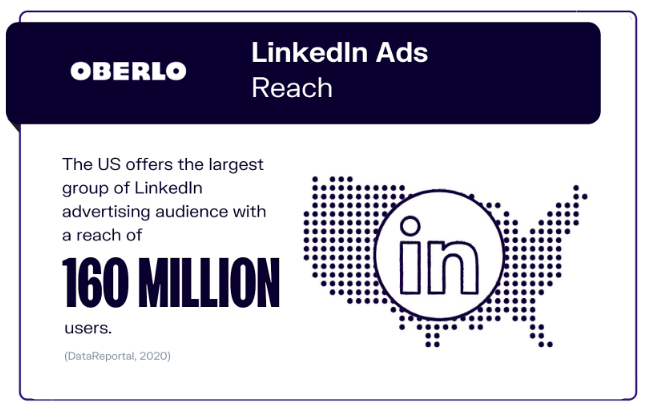
9. LinkedIn’s Role in Buyer’s Journey
Given the increasingly widespread use of social media these days, it should come as no surprise that social networks today have immense influence over a buyer’s purchase decision.
In fact, it is estimated that more than seven out of ten buyers are influenced by social media when deciding to purchase a product or service.
Of all the social networks, LinkedIn seems to have the upper hand. 52 percent of buyers list LinkedIn as the most influential channel during their research process (Demandbase, 2018). This is followed by 42 percent of buyers who list blogs as having the biggest influence on their research.
In general, buyers who rely on social media for their purchase decision do so to get recommendations and opinions and to connect with sellers.
10. LinkedIn’s Mobile Traffic
With the rise of the usage of mobile devices, mobile web traffic has logically increased along with it. As a matter of fact, overall mobile traffic is expected to increase five-fold between 2018 and 2024.
To further put things into perspective, the average smartphone user in the US currently consumes 8.6GB of data per month. This is expected to increase to 50GB come 2024.
Currently, the majority of overall internet usage is mobile, and LinkedIn is certainly no exception to this: 57 percent of LinkedIn’s traffic comes from mobile devices (LinkedIn, 2018).
Even though this is a relatively low figure compared to Facebook (at 88 percent) and YouTube (at 70 percent), the fact that LinkedIn gets most of its traffic from mobile devices should be a big enough motivation for ecommerce store owners to consider a mobile commerce strategy – at least for their LinkedIn marketing efforts.
Conclusion
These LinkedIn statistics serve to help you better understand the platform and its users. That way, you can mine its potential to the maximum to drive traffic from LinkedIn to your website.
Whether you’re including LinkedIn as part of your sales process or simply using it as a free marketing channel for your ecommerce business, it’s a channel that’s not to be missed out on.
So if you’re not already on it, you might want to consider jumping on the bandwagon and use these LinkedIn statistics to your advantage before your competitors who are already on there get too far ahead.
2004 – Facebook
2005 – YouTube
2006 – Twitter
2010 – Instagram
2011 – SnapChat
2019 – TikTok


